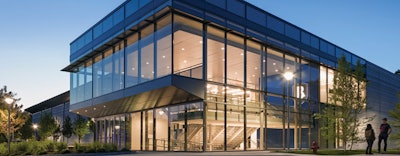
When Bentley University signed on to the American College & University Presidents' Climate Commitment, school officials were serious about ensuring that sustainability was a part of the university's mission. By 2010, Bentley had finalized its climate action plan, committing to a 50 percent reduction in carbon emissions by 2015, a 70 percent reduction by 2020 and carbon neutrality by 2030. The school nailed its 2015 target, and despite the decision to build its NCAA Division I hockey team a 2,000-seat multipurpose ice arena — a type of building known to be an energy hog — Bentley is still on track to hit its 2020 goal.
"Any time you're adding new buildings to your campus portfolio, your energy use is going to go up," says Amanda King, executive director of Bentley's Office of Sustainability. "It's not only that we were adding a new building, it's that we were adding a new building with a hockey rink inside of it. So that stood out to me as, 'Whoa, we need to really think about how we do this.' "
Little did King know at the time, Bentley would succeed in constructing the school's first LEED-certified building, and the first standalone LEED Platinum-certified ice arena in the entire country.
Jan Taylor, an architect at Architectural Resources Cambridge (ARC), says Bentley officials weren't even after a Platinum certification. "Interestingly enough, LEED Platinum was not a goal when we started the project," Taylor says. "The building was to be LEED Silver-certified. All of their new construction has to be LEED Silver or better, and so we sort of went in knowing that we needed to be sustainable."
As the project progressed, Taylor says team members came to the realization that they weren't that far off from a truly distinguished certification. "Once we started looking at really efficient mechanical systems and a good tight building envelope, we were squarely in the LEED Gold range, and at that point it became clear that with a little extra effort, we could tip the scales into Platinum, and that would be something they could really hang their hat on."

Tipping to Platinum
The project budget had been capped at $45 million, and the project team didn't increase the up-front cost of the building to get to Platinum. King says that's due to a trial-and-error process that took a lot of effort from a team with a shared vision.
"There was a lot of 'Okay, do you think ground source heat pumps are going to work in this building? We don't know, so let's run a model and see if it works,' " she explains. "It's not as simple as just running a model, it's asking your project team to spend the extra time to do it. But it's so helpful to have the data, and we decided ground source heat pumps were not going to be great in this building, and we decided not to do it. It makes us feel more confident in the things we decided to do, because they made sense both from a sustainability standpoint and from a cost standpoint."
One solution that had a big impact on the facility's energy use was a massive solar array that covers the entire roof of the building. "It's a large building with a large roof area that allowed us to install 1,400 solar panels on the roof, which generate about 40 percent of the annual electricity needs for the arena," says ARC's Philip Laird, who also worked on the building.
King says the performance of the solar array has thus far exceeded expectations, but also notes that the system was installed in December 2017 and the ice in the facility was only down from February until May of this year. "So it was really half a season, and this coming year will be our first real look at what this building does for an academic year and the first full hockey season."
Another energy-efficient facet of the facility is a heat-recovery loop that captures waste heat off the ice plant. "We're using that to preheat domestic hot water in the faucets and showers in the building," King explains. "That reduces the amount of natural gas we have to use, so it's brilliant things like that that have really made the difference."
The budget constraints placed on the project from the beginning seemed to serve as a catalyst for ingenuity. From a deliberate siting process to the building's overall composition, the project team was always looking for efficiencies. "When we lifted that roof to get that slope, it gave us a great opportunity to bring that daylight in from the north," explains Laird. "So we did a lot of modeling of solar angles and glare 365 days a year to make sure that we could maximize the daylight within the facility but still ensure that we had an excellent ice surface at all times."

More than a hockey rink
Completed in Bentley's centennial year, the arena was meant to serve as a modern, efficient and flexible facility that would not only host the school's only Division I sport, but also serve as a gathering place for a variety of events. "It was very much their way to brand themselves as forward-looking with a multipurpose building that is of a different vocabulary than the rest of their campus," says Taylor. "The word that they used repeatedly in the RFP was 'aspirational.' "
King says the Bentley Arena has become a beacon on a campus primarily comprised of 50s-style red-brick structures, that hadn't seen a new building in more than a decade. "It's a real point of pride for us," she says. "Everybody in our community can come into this building and experience it and have a great time, and it's not just about hockey games. For instance, we have convocation for our new freshman class and a career fair that we host there."
Notably, the arena is also used as a classroom of sorts, allowing students in the university's sustainability program to learn about how the building uses and conserves energy. "We want to use this building as a living laboratory for our students," King says. "There are a ton of sub-meters in the building, so we know how much electricity we're using, natural gas, water, and what the solar installation on the roof is producing. So we're working to capture that data and provide it to professors for use in the classroom."

Do the due diligence
The Bentley Arena has set a precedent, proving that building a sustainable facility — even an ice arena, or especially an ice arena — makes sense from both environmental and cost-saving perspectives. King says the school has gotten a number of inquiries from other institutions embarking on similar projects, and both Bentley and ARC are making a concerted effort to share what they learned along the way.
"People ask all the time, 'Why doesn't everybody just do this?'," she says. "Because obviously we're saving money as well. It seems like a no-brainer, but it's literally about having a team that's all in on committing to sustainability and creativity in design. And it's about taking the extra hour, or five hours a day, to do the due diligence that's necessary on different options for reducing energy use in the building."
This article originally appeared in the October 2018 issue of Athletic Business with the title "Designing the First LEED Platinum Ice Arena in the United States." Athletic Business is a free magazine for professionals in the athletic, fitness and recreation industry. Click here to subscribe.





































